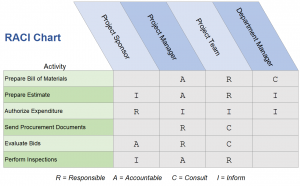
Resource allocation is the process of assigning and scheduling resources to project tasks.
Resources are the life blood of project management. Resources are used to carry out the project, and are returned to their owners if not consumed by the project.
There are 6 steps to performing a proper resource allocation:
- Divide the Project into Tasks
- Assign the Resources
- Determine resource attributes
- Resource Leveling
- Re-allocate as necessary
- Track resource utilization
Divide the Project into Tasks
In project management, the project is divided into tasks and managed on a task, rather than a project, level. Resource allocation is an integral component of this process because each task is assigned the necessary resources, and the resources are managed by task.
During the project planning phase, the project’s constituent tasks are determined and listed, like this:
| ID | Task |
|---|---|
| 100 | Dig Holes |
| 200 | Build Fence |
Each task is assigned a start and end date and a budget, like this:
| ID | Task | Start | End | Budget |
|---|---|---|---|---|
| 100 | Dig Holes | July 1 | July 10 | $1,000 |
| 200 | Build Fence | July 8 | July 31 | $9,000 |
This is called a work breakdown structure (WBS), and it is the minimum planning phase for a small project, according to all of the three main project management methodologies.
Once the project is successfully divided into tasks, the resources can be assigned.
Assign the Resources
Each task requires resources in order to be successfully performed. Most tasks require at least a human resource to carry out some sort of action. Usually, the person starts with some input materials which are used to produce an output.
Generally, there are five types of resources:
- Labor
Human resources are an integral part of most projects. The project team has needs that require active management, like:- A satisfying work environment that does not involve conflicts with other team members.
- Making an important contribution to the project, and/or greater society.
- Leaving the project with something more than they started with, for example additional knowledge or skills, or a strong resume/CV entry that results in a better chance at future work.
- Equipment
Tools and equipment that are used to produce the product, but don’t become part of it, must be identified and allocated to each task. This equipment must be paid a reasonable rate that takes into account the wear and tear experienced during the project. Specialty equipment often requires significant investment of time and money. - Materials
Materials that become a part of the final product must be allocated so that they can be procured at the right time and their availability is confirmed. - Facilities
Buildings and work areas are often a significant cost to the project. If they are not readily available, they also require space in the project schedule and budget to ensure they are ready for the project team. - Miscellaneous
Most projects require other resources that impact the budget or schedule. This can include project financing and insurance costs, performance bonding, administration, contingencies, risk premiums, transportation and delivery, or any other item necessary to perform the project.
The resources are assigned to each task, so that the table looks like this:
| ID | Task | Start | End | Budget | Resources |
|---|---|---|---|---|---|
| 100 | Dig Holes | July 1 | July 10 | $1,000 | Bob, shovel |
| 200 | Build Fence | July 8 | July 31 | $9,000 | Bob, Bill, shovel, fence posts, fence material |
For the human resources (project team), it is often helpful to communicate project roles using a RACI chart, pronounced “racy,” which assigns each task to each team member according to one of the four responsibility levels:
- Responsible (R)
- Accountable (A)
- Consulted (C)
- Informed (I)
All project managers use RACI charts, even if they don’t know it. Writing out the chart is a highly effective way to communicate project roles to project members and ensure there is no confusion.
Determine Resource Attributes
 Each resource comes with attributes (project manager lingo) which must be sufficient to carry out the project work. These attributes include:
Each resource comes with attributes (project manager lingo) which must be sufficient to carry out the project work. These attributes include:
- Grade
Grade refers to the technical specification level of the resource. In this case, the length of the fenceposts, the depth of the holes, and the strength of the fence material are all characteristics of grade. In short, the resources must be adequate for the task. - Skill
Skill is the same as grade but specific to the human resources. Bill and Bob, in this case, must know how to pound the fence posts and be strong enough to drive the posts. - Quality
Quality and grade are not the same thing. Quality refers to the degree to which the resource meets specifications, as opposed to grade which refers to the specification level itself. For example, poor quality fence material arrives at the site it is not acceptable and must be rejected, adding unexpected costs and schedule implications. This is different from the grade of the fence material, which can be low. The fence may not need high grade fence material. Low grade is acceptable (in the right circumstances), whereas low quality is never acceptable. - Resource-specific attributes: Size, shape, length, speed, color, strength, etc.
Each resource has many specific attributes that define its function. for example, if the paint is supposed to be brown, but a green paint arrives on site, it is probably still high quality as well as grade, yet not sufficient for the project. The required attributes must be determined individually for each resource. - Availability
In project management lingo this is called a resource calendar. The resource calendar can range from a simple listing of employee vacation time to sophisticated material tracking software. But its purpose is to ensure the project resource is available when needed.
At this stage we drill down into the table for each resource. Hence, a new table of information is formed for each resource:
| Resource | Attributes | Availability |
|---|---|---|
| Bob | Needs 1 week notice | |
| Shovel |
|
Immediately |
Resource Leveling
Project schedules are usually created without the resources in mind. That is, the network diagram and gantt chart are optimized to minimize the schedule duration based on the number of hours or days required to carry out each task, but the resources assigned to the task might be highly volatile, incurring sometimes major cost and schedule implications.
For example, if we need Bob for 2 hours one day and 18 hours the next, we might need to pay him overtime thereby driving the project over budget.
Resource leveling refers to the process of inspecting the resources to ensure their use is as “smooth” and level as possible. It is a common scenario that it is more advantageous to extend the project schedule to avoid large spikes and dips in resource usage.
In addition, the resources used to carry out those tasks must be procured (purchased), delivered, and prepared. During the project, they must be maintained and serviced. All of these tasks must be accounted for within the project schedule and budget.
Re-allocate as Necessary
Throughout the project, resource re-allocation tends to be a constant and inescapable function of the project manager.
Resources are scarce. They sometimes do not show up on time, are needed by other projects, or lose their usefulness over time. Many things can happen that require a shift of resources from one task to another, or a change in the project schedule or budget.
Track Utilization Rates
It is a surprisingly common occurrence that a resource arrives at a project and sits idle for a long period of time.
It is equally common that project managers have no idea that the resource is being paid for but not being used.
A simple solution is to track resource utilization rates. The utilization rate is simply the percentage of billable time:
Utilization Rate = Number of Billable Hours / Number of Total Hours
For example, if Bill worked on the project 4 hours out of a possible 40 available hours for the week, his utilization rate is 4 / 40 = 10%. Clearly this would suggest corrective action is warranted on the part of the project manager.












Leave a Reply